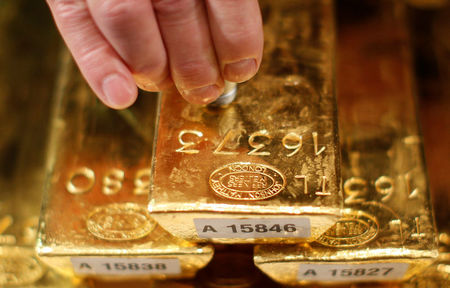
Investing.com– Gold prices rose on Wednesday, supported by a weaker dollar and the prospect of increased U.S. trade tariffs stirring up geopolitical tensions..
Spot gold rose 0.2% to $2,637.99 an ounce, while gold futures expiring in February rose 0.6% to $2,662.89 an ounce by 3.14 p.m. ET (2014 GMT).
Dollar dips on in-line inflation data; Trump threatens more trade tariffs
The dollar dipped Wednesday following data showing the core PCE price index, the Fed’s preferred inflation measure, met expectations in October, keeping the prospect of another rate cut next month on the table.
Downside in the greenback comes even as U.S. President-elect Donald Trump threatened to impose additional trade tariffs on China, Canada and Mexico when he takes office, sparking increased concerns over a renewed trade war between the world’s largest economies.
Analysts warned that any steep tariffs could undermine global economic growth and also push up U.S. inflation- which presents a higher outlook for interest rates in the long term.
Safe haven demand for gold was also stymied by U.S. President Joe Biden announcing a ceasefire deal between Israel and Hezbollah, heralding a de escalation in the Middle East conflict.
Other precious metals were marginally positive on Wednesday. Silver futures fell 0.9% to $30.547 an ounce, while platinum futures rose 0.4% to $933.20 an ounce.
Among industrial metals, benchmark copper futures on the London Metal Exchange rose 0.6% to $9,023.00 a ton, while copper futures expiring in February rose 0.7% to $4.1467 a pound.
Trump policies to limit gold appetite- BofA
Trump’s economic policies, which are expected to invite higher U.S. growth and a stronger dollar- could limit investor appetite for gold, Bank of America analysts warned in a recent note.
Trump is expected to dole out more corporate tax cuts and economically expansionary policies in his second term, supporting growth but also pushing up inflation.
This trend is expected to keep U.S. interest rates relatively high in the long term, underpinning the dollar and Treasury yields, while limiting demand for gold.
Precious metals, especially gold, were nursing steep losses through November after Trump’s election victory near the beginning of the month.
Industrial metal prices were pressured by the prospect of more U.S. hawkishness towards China, which is a major importer of copper and other base metals.
(Peter Nurse, Ambar Warrick contributed to this article)
This post is originally published on INVESTING.





